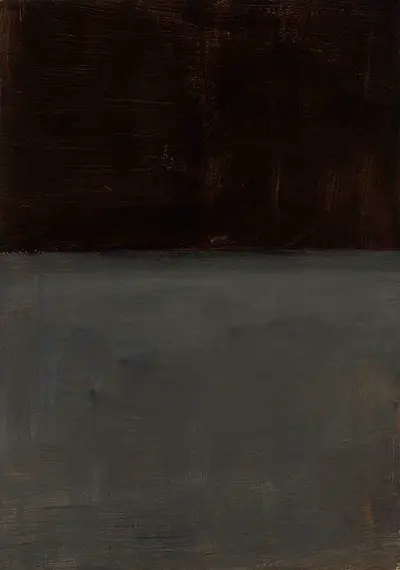In fall 1967, after teaching at the University of California at Berkeley over the summer, Rothko returned to New York, where he remained until his death in 1970. Despite the deterioration of his health from 1968, Rothko was prolific in his final years, painting primarily with acrylics on paper and sometimes on canvas, which he tacked and taped to his studio walls. In 1969, Rothko moved to a predominantly darker palette of browns, grays, and black. As in Untitled (Brown and Gray) (1969), he reduced the composition of most of his works to only two planes surrounded by a white border, which adds to the perception of flatness in the image. Frequently, the top mass appears heavier and darker than the bottom.
The proportion of the border to the interior configuration was great concern to Rothko. In contrast to his earlier works in which the floating planes have both horizontal and vertical boundaries, the two planes of color in these later works meet at a line that extends across the width of the painted surface. Although the acrylics are more opaque than the oil paint he used in his earlier paintings, the brushstroke in Untitled (Brown and Gray) appears to allow light to shine through the painted surface. Due to the dark, somber palette and restrained composition of some of the artist's late paintings (others were lighter and brighter in hue), they have often been understood to indicate Rothko's depressed mental and physical state and to refigure his suicide. Yet despite their deeper and quieter tone these works are also graceful and harmonious and suggest a new development in the artist's oeuvre.
Whilst this was one of Rothko's best works from his darker palette, other items worth checking out include the likes of Untitled (Black on Grey), Black on Maroon and Black on Dark Sienna on Purple. There was also a whole series of canvases produced for the Rothko Chapel which remains open to visitors today and is an excellent example of how he considered the environment in which his work was displayed, and not just the artworks themselves. These all contrast markedly with the bright tones used elsewhere, as well as the Surrealist work from earlier in his career. His oeuvre was far more varied and interesting than many realise, with most only being aware of his bright Color Field work which decorate some of the most prominent art galleries and museums in the world.

